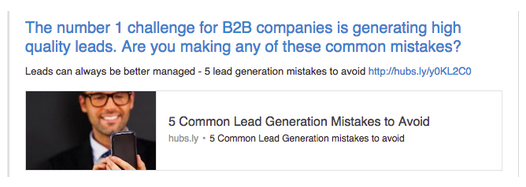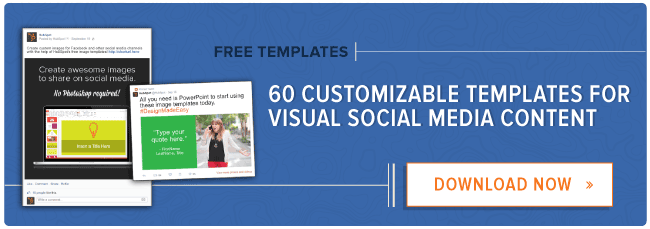As a marketer, what's the first thing you do when you log into LinkedIn?

Do you update your profile, look for recruits, check your feed?
As the "professional" social network, LinkedIn is often overlooked as a place for the "social" dynamic, but I've found it's actually one of my favorite places to look for new content. In particular, LinkedIn groups provide a fantastic breeding ground for conversation if you set it up to be successful.
As the Community Manager at HubSpot, I am a part of a LOT of groups on various social networks. One of my responsibilities is the moderate our Inbound Marketing group on LinkedIn, “Inbound Marketers - For Marketing Professionals”.

The idea of this group is to provide a forum for those interested in or learning about inbound marketing. This is such a cool group because it contains the best kinds of marketers- ones who understand posting content is important.
With over 123,000 members who love posting content, this can also be a beast to moderate. In order to allow for real, helpful, continuous conversations, we have to make a few tough decisions when moderating the LinkedIn group. In this post, I'll give you my four rules for moderating LinkedIn groups and how you can apply them to your own.
Rule #1: Include the right people in the community.
The first step of good conversation is finding other people with whom to speak. The inbound marketers group is a diverse community. Some are already marketers, some want to be marketers, and some just want to learn about the marketing side of their business. It takes many viewpoints to have a really good conversation. Each morning, I will check the LinkedIn group and approve members from the day before. We ask each applicant to provide us a little additional information via form to confirm they will be a good fit for the group so we make sure we people are there for the right reasons. I try to include everyone in the group who seems like they will really benefit from inbound marketing advice. This mostly means their profile makes it clear they are a real person (not a bot) and it looks like they have made an effort to do something with their LinkedIn profile at all. Luckily (though challenging) for us, many of those people approved then want to submit content.
Once we have the audience, it's important to keep people's attention, to make sure the conversation is still flowing. In order to make sure our discussions gain traction we try to post between 3-8 new posts a day. Any more than that and people would be overwhelmed with content. To keep that number at a reasonable level, we have to establish strict rules for the kinds of content we approve in order to help everyone get the most use possible out of the group. We also have to make sure our each of our members provide value to the group as a whole.
Rule #2: Approve content that provides value to the majority of the group.
As I mentioned, we get probably over 100 posts a day for the "Inbound Marketers" group. While many of these posts contain good articles or possibly relevant information, in order to make sure the group stays a conversational destination and not a glorified RSS or Twitter feed, we have to look at the value each post will provide in engaging the group. Posts that meet this criteria fall into one of about four buckets. To check the fit in each bucket, I ask myself a series of questions about the content at hand.
In general, the most overarching rule about the post is that it gives, it doesn't take from the group. Basically, it's trying to provide value to the group and not just drive traffic to the poster's own traffic. The way a post can give is it is one of the following:
-
Relevant questions for advice/discussions. This one is a tricky one to define because “relevance” carries a different meaning for everyone.
To preface, we ask in our group rules that people posting pose their post the form of a question. That makes it easiest for creating a discussion. When thinking about whether it meets this criteria, I start by asking, is this a rhetorical question meant to just meet the “question” requirement? Is there one simple answer to this question? Can I get an answer by googling it? If the answer to any of these is yes, it’s not worth posting.
Any question asked here should be asking for legitimate advice, provide a genuine ground for debate or have a real purpose I can answer.
Takeaway: questions should be legitimate questions that provide a grounds for real, stimulating discussion, and from which most of the group can learn. -
An interesting article with an accompanying question about the article’s content.
Many people get stuck on this one. The key to this is to actually find an article where the group can learn something they didn’t already know, and extract relevant information quickly.
When thinking about this, I start by asking, is this a link to an article I could have easily just found myself? I work with a group of smart marketers, they read a lot and may have seen it already today. If so, is there an important takeaway posted with the article I would have otherwise missed? I next move on to ask, is this an article from your company? If so, does it provide any real value besides contributing to your campaign. Is it from MY company? If so, since people in my LinkedIn group are likely also following my LinkedIn page and have already seen this article, are you providing a new perspective I didn’t already? These are just some of the questions you can ask yourself.
NOTE: this is probably one of the hardest thing for group members. Since inbound marketers in particular provide a lot of great content, and understandably want to promote it, we get a lot of great content. Since we have SO MUCH great content, and so little time, we really have to focus on things that are going to provide new value to group members.
Takeaway: Any articles must provide new value. -
Important industry news.
Sometimes there is breaking news in your industry and it is worth discussing. Two great examples of this are the recent Google Algorithm update that occurred last month or the now-lauded for its marketing success Mayweather vs Pacquaio fight. This is timely content worth sharing, but everyone typically thinks of this too. In this case, we select articles that provide new, interesting value.
Takeaway: News is good, news with questions is better. -
Really darn catchy, unusual, content.
Okay, we admit, we’re human. Sometimes someone posts an article that really seems like it is relevant to the group, and writes a really good headline and we can’t help but click. This is a harder one to defend because it’s like explaining why a college didn’t admit a certain parent’s child. We’re sure lots of people write good content, but it needs to provide a really unique, obvious value that we haven’t seen already today and often comes from people who are really paying attention to the kinds of questions the group is always debating.
In this category, I’m most likely to approve articles that are solving a problem, and where I genuinely haven’t read anything like it in the last week. I will also only approve a very small quantity (1-2) of these per week since we want to avoid a graveyard of posts without any discussion on them.
Takeaway: Really catchy headlines and killer content do count for something.
Since we get a lot of posts in our group, and so do our marketers, the next important thing is, are people going to quickly see value in this post? In this case, formatting is important for an eye-catching post.
Rule #3: Include posts that are well formatted.
Since the point of our LinkedIn group is to facilitate relevant discussions, we first look for a title that includes a question. Ideally it also provides a clear context as to the content and is easy for the reader to quickly understand the value and the ask. This is similar to writing a good blog title.
If providing a link to the post, the link should also be available in the body of the post so that I can see it when I am moderating. If I don't know what a post involves, I am very unlikely to approve it.
Rule #4: Encourage helpful group members.
One of the biggest things to remember is that groups are not just feeds, they are communities. As such, members should feel engaged and welcomed to come back. Besides posting valuable content, one of the ways we try to help this is by rewarding helpful groups members with favor if they try to post. In order to gain this reward, though, they have to be a good member in the first place. There are a few important keys to being a good group member:
- Limit your submissions to 2-3 posts a day. Nothing kills a conversation faster than someone who just talking, and isn’t listening. Just like any other form of social media, a group should not be used for posting just anything. While tools like our social inbox tool make it easy to post to any network in seconds, we suggest people post only their most relevant content (everything can’t be “most relevant”).
- Own your conversations. I read a great article the this morning about how to post on reddit, and one of the tips was to own your conversations. I believe the tip applies here as much as it does any other social network. If you post a question, stick around to see what people say, engage with them. After all, conversations should be two-sided.
- Stop, participate and listen. Groups on social media are not meant to be billboards. One of the most important aspects of a community is to actually build up karma and to provide value. Ideally the content of the group is relevant to you. If it’s not, let the moderator know, if it is, participate. That way we know what kinds of content to continue providing.
After extensive practice, we have found that following the above rules allows for a really high-quality group discussion, but not everyone has the same moderating concerns we do. Now that we have gone over the rules of moderating a large group, you may be wondering-
What is the takeaway for smaller groups?
All of the above context is what we do for HubSpot, but the same suggestions can be easily applied to smaller groups and groups in other industries. It is always important to make sure members approved are productive and real group members. When looking to submit or add content:
- It should provide real, tangible value to the vast majority of group members
- It should be a basis for discussion for group members
- It should not be self-promotional (at least, not the first priority)
Groups on social media can be such a powerful asset, but only when they are full of useful content. The more useful content submitted, the more important it is to ensure yours provides value. With valuable groups, come spectacular conversations, and ultimately better marketing.
What do you look for when moderating your LinkedIn groups? Anything we can improve about ours?








